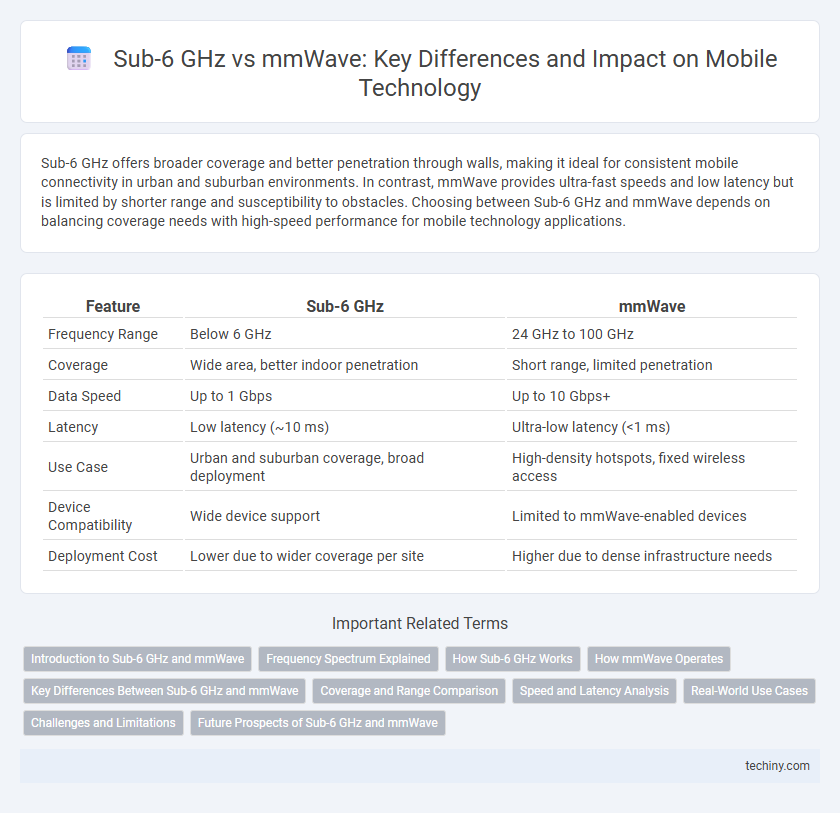Sub-6 GHz offers broader coverage and better penetration through walls, making it ideal for consistent mobile connectivity in urban and suburban environments. In contrast, mmWave provides ultra-fast speeds and low latency but is limited by shorter range and susceptibility to obstacles. Choosing between Sub-6 GHz and mmWave depends on balancing coverage needs with high-speed performance for mobile technology applications.
Table of Comparison
| Feature | Sub-6 GHz | mmWave |
|---|---|---|
| Frequency Range | Below 6 GHz | 24 GHz to 100 GHz |
| Coverage | Wide area, better indoor penetration | Short range, limited penetration |
| Data Speed | Up to 1 Gbps | Up to 10 Gbps+ |
| Latency | Low latency (~10 ms) | Ultra-low latency (<1 ms) |
| Use Case | Urban and suburban coverage, broad deployment | High-density hotspots, fixed wireless access |
| Device Compatibility | Wide device support | Limited to mmWave-enabled devices |
| Deployment Cost | Lower due to wider coverage per site | Higher due to dense infrastructure needs |
Introduction to Sub-6 GHz and mmWave
Sub-6 GHz and mmWave are two primary frequency bands used in 5G mobile technology, each with distinct characteristics. Sub-6 GHz offers broader coverage and better penetration through obstacles due to its lower frequency range, typically between 1 GHz and 6 GHz. In contrast, mmWave operates at much higher frequencies, generally above 24 GHz, providing ultra-high speeds and low latency but with limited range and sensitivity to physical barriers.
Frequency Spectrum Explained
Sub-6 GHz and mmWave represent two critical frequency spectrums in mobile technology, each offering distinct performance characteristics. Sub-6 GHz frequencies, ranging from 600 MHz to 6 GHz, provide broader coverage and better penetration through obstacles, making them ideal for wide-area and indoor connectivity. In contrast, mmWave operates between 24 GHz and 100 GHz, delivering ultra-high-speed data and low latency but with limited range and reduced ability to penetrate buildings.
How Sub-6 GHz Works
Sub-6 GHz technology operates within frequency bands below 6 gigahertz, enabling broader coverage and better penetration through obstacles such as walls and buildings compared to higher frequencies. It transmits signals using longer wavelengths, which improve signal stability and indoor reception, making it ideal for widespread 5G deployment. Mobile networks utilizing Sub-6 GHz balance speed and range, supporting reliable connectivity in urban and rural environments.
How mmWave Operates
mmWave operates by utilizing high-frequency radio waves typically between 24 GHz and 100 GHz, enabling extremely fast data transmission speeds and low latency for mobile technology. It requires line-of-sight communication and dense network infrastructure due to its limited range and poor penetration through obstacles like walls and foliage. This spectrum supports advanced applications such as augmented reality, ultra-high-definition streaming, and real-time gaming by delivering enhanced bandwidth and capacity.
Key Differences Between Sub-6 GHz and mmWave
Sub-6 GHz frequencies offer broader coverage and better penetration through obstacles, making them ideal for wide-area 5G deployment and indoor connectivity. In contrast, mmWave operates at much higher frequencies, delivering ultra-fast data speeds and low latency but with limited range and poor obstacle penetration. These key differences influence network design, with Sub-6 GHz ensuring reliable coverage and mmWave focusing on high capacity hotspots.
Coverage and Range Comparison
Sub-6 GHz frequencies in mobile technology offer broader coverage and longer range compared to mmWave bands, which typically cover shorter distances due to higher frequency signals being more susceptible to obstacles and attenuation. Sub-6 GHz efficiently penetrates walls and buildings, providing consistent indoor and outdoor connectivity, whereas mmWave delivers ultra-high speeds but requires line-of-sight conditions, making it ideal for dense urban hotspots. Network operators often deploy Sub-6 GHz for widespread coverage and mmWave to supplement capacity in high-traffic areas.
Speed and Latency Analysis
Sub-6 GHz frequencies provide broader coverage and more stable connections with moderate speeds, typically ranging from 100 Mbps to 1 Gbps, while mmWave technology offers significantly faster speeds reaching up to 10 Gbps with ultra-low latency around 1 millisecond. The higher frequency bands in mmWave enable greater data throughput but suffer from limited range and poor penetration through obstacles, impacting consistent performance compared to Sub-6 GHz. In 5G networks, balancing Sub-6 GHz's wider coverage and mmWave's exceptional speed and latency characteristics is crucial for optimizing user experience across diverse environments.
Real-World Use Cases
Sub-6 GHz frequencies enable broader mobile coverage and better penetration through buildings, making them ideal for urban and suburban use where consistent connectivity is essential. Millimeter wave (mmWave) technology provides ultra-high speeds and low latency, suited for dense environments like stadiums or indoor venues where high data capacity is critical. Real-world implementations often combine Sub-6 GHz for wide-area coverage with mmWave for hotspots requiring exceptional performance.
Challenges and Limitations
Sub-6 GHz frequencies offer broader coverage and better penetration through obstacles but face congestion and limited bandwidth, restricting peak data rates for 5G applications. mmWave technology provides ultra-high speeds and low latency but suffers from poor range, higher susceptibility to physical obstructions like buildings and weather, and increased deployment costs due to the need for dense small cell networks. Both frequency bands necessitate strategic planning to balance coverage, capacity, and infrastructure expenses in mobile network deployments.
Future Prospects of Sub-6 GHz and mmWave
Sub-6 GHz frequencies offer broader coverage and better building penetration, making them vital for expanding 5G networks in suburban and rural areas. mmWave delivers ultra-high speeds and low latency, ideal for dense urban environments and advanced applications like augmented reality and autonomous vehicles. Future 5G deployments will likely integrate both, leveraging Sub-6 GHz for widespread connectivity and mmWave for capacity-intensive hotspots.
Sub-6 GHz vs mmWave Infographic

 techiny.com
techiny.com